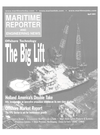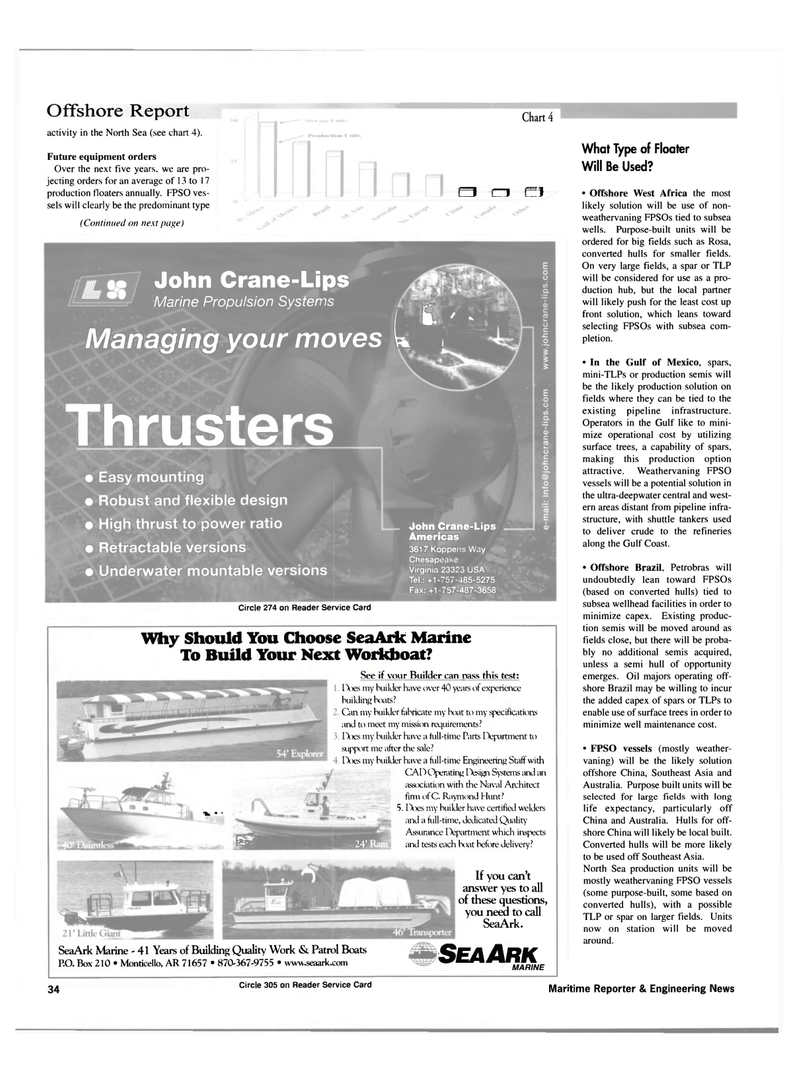
Page 34: of Maritime Reporter Magazine (April 2001)
Read this page in Pdf, Flash or Html5 edition of April 2001 Maritime Reporter Magazine
Offshore Report activity in the North Sea (see chart 4).
Future equipment orders
Over the next five years, we are pro- jecting orders for an average of 13 to 17 production floaters annually. FPSO ves- sels will clearly be the predominant type (Continued on next page)
Chart 4 ri n ni
John Crane-Lips
Marine Propulsion Systems I v I L4 I I I I V^ I I V WIWI V/ I I w r W w » « » w r ®'v Managing your moves W .
Thrusters • Easy mounting • Robust and flexible design • High thrust to power ratio • Retractable versions • Underwater mountable versions
John Crane-Lips
Americas 3617 Koppens Way
Chesapeake
Virginia 23323 USA
Tel.: +1-757-485-5275
Fax: +1 -757-487-3658
Circle 274 on Reader Service Card
What Type of Floater
Will Be Used? • Offshore West Africa the most likely solution will be use of non- weathervaning FPSOs tied to subsea wells. Purpose-built units will be ordered for big fields such as Rosa, converted hulls for smaller fields.
On very large fields, a spar or TLP will be considered for use as a pro- duction hub, but the local partner will likely push for the least cost up front solution, which leans toward selecting FPSOs with subsea com- pletion. • In the Gulf of Mexico, spars, mini-TLPs or production semis will be the likely production solution on fields where they can be tied to the existing pipeline infrastructure.
Operators in the Gulf like to mini- mize operational cost by utilizing surface trees, a capability of spars, making this production option attractive. Weathervaning FPSO vessels will be a potential solution in the ultra-deepwater central and west- ern areas distant from pipeline infra- structure, with shuttle tankers used to deliver crude to the refineries along the Gulf Coast. • Offshore Brazil, Petrobras will undoubtedly lean toward FPSOs (based on converted hulls) tied to subsea wellhead facilities in order to minimize capex. Existing produc- tion semis will be moved around as fields close, but there will be proba- bly no additional semis acquired, unless a semi hull of opportunity emerges. Oil majors operating off- shore Brazil may be willing to incur the added capex of spars or TLPs to enable use of surface trees in order to minimize well maintenance cost. • FPSO vessels (mostly weather- vaning) will be the likely solution offshore China, Southeast Asia and
Australia. Purpose built units will be selected for large fields with long life expectancy, particularly off
China and Australia. Hulls for off- shore China will likely be local built.
Converted hulls will be more likely to be used off Southeast Asia.
North Sea production units will be mostly weathervaning FPSO vessels (some purpose-built, some based on converted hulls), with a possible
TLP or spar on larger fields. Units now on station will be moved around. ggf ^^ 24'
See if your Builder can pass this test;
Does my builder have over 40 years of experience building boats?
Can my builder fabricate my boat to my specifications and to meet my mission requirements?
Does my builder have a tull-time Parts Department to support me after the sale?
Does my builder have a full-time Engineering Staff with
CAD Operating Design Systems and an association with the Naval Architect firm of C. Raymond Hunt? 5. Does my builder have certified welders and a full-time, dedicated Quality
Assurance Department which inspects and tests each boat before delivery?
Why Should You Choose SeaArk Marine
To Build Your Next Workboat?
If you can't answer yes to all of these questions, you need to call
SeaArk.
SEAARK
MARINE
SeaArk Marine - 41 Years of Building Quality Work & Patrol Boats
RO. Box 210 • Monticello, AR 71657 • 870-367-9755 • www.seaark.com •>> • • 34 Circle 305 on Reader Service Card Maritime Reporter & Engineering News

 33
33

 35
35
